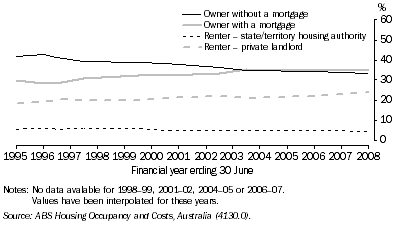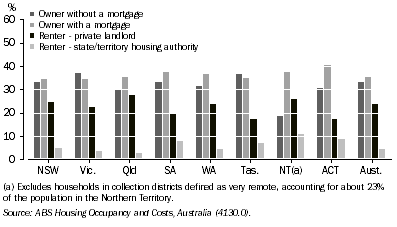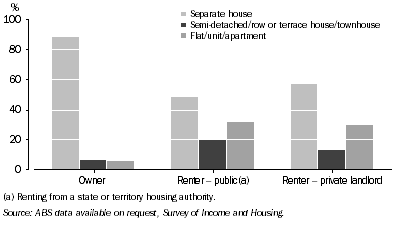HOME OWNERS AND RENTERS
The legal rights and obligations that households have in relation to the dwelling in which they live vary considerably according to tenure type. For example, those who own their home have greater security of tenure than most renters, whose occupancy rights are subject to review at relatively frequent intervals. Owners also have more freedom than renters to modify the dwelling to suit their specific needs and tastes, to keep pets, take in boarders or run a business from home. In the course of repaying their home loans, owners accumulate wealth in the form of home equity which can then be used to secure finance for other purposes.
On the other hand, renting can have advantages over home ownership, such as greater flexibility to move elsewhere at short notice, lower housing costs than many owners repaying a mortgage, and the opportunity to invest in other assets which may yield higher returns than home ownership. Households renting from a state or territory government housing authority (public renters) generally enjoy lower housing costs and greater security of tenure than those renting from a private landlord.
At the 1966 Census of Population and Housing, 71% of all occupied private dwellings were either owned outright or owned with a mortgage by their occupants. Following the 1967 Referendum and changes to the Census Indigenous question in 1971, the Indigenous count increased 45%. Lower average Indigenous home ownership rates at that time, compared to the population as a whole, contributed in part to the decrease, to 69%, in average home ownership recorded in the 1971 Census. Since then the rate of home ownership in Australia, as measured in the Census, has ranged between 68% and 70% (table 10.5).
10.5 ALL OCCUPIED PRIVATE DWELLINGS, By tenure type |
|
 | Owner without a mortgage | Owner with a mortgage | All owner occupied private dwellings | Renter | Other Tenure | Total(a) | Proportion of owner occupied private dwellings |
| Year | `000 | `000 | `000 | `000 | `000 | `000 | % |
|
| 1966(b) | na | na | 2 231.9 | 835.1 | 59.6 | 3 126.5 | 71.4 |
| 1971(b) | na | na | 2 468.9 | 1 001.3 | 119.3 | 3 589.5 | (c)68.8 |
| 1976 | 1 306.3 | 1 437.8 | (d)2 761.5 | 1 044.5 | 232.5 | 4 040.5 | (e)68.3 |
| 1981 | 1 548.9 | 1 542.9 | (d)3 178.9 | 1 164.5 | 190.6 | 4 534.0 | 70.1 |
| 1986 | 1 981.9 | 1 604.4 | 3 586.3 | 1 334.4 | 174.1 | 5 094.8 | 70.4 |
| 1991 | 2 362.0 | 1 561.3 | 3 923.2 | 1 560.6 | 210.3 | 5 694.2 | 68.9 |
| 1996 | 2 658.0 | (f)1 656.1 | 4 314.0 | 1 866.0 | 67.8 | 6 247.8 | 69.0 |
| 2001 | 2 810.9 | (f)1 872.1 | 4 683.0 | 1 953.1 | 101.3 | 6 737.4 | 69.5 |
| 2006 | 2 478.3 | (f)2 448.2 | 4 926.5 | 2 063.9 | 65.7 | 7 056.1 | 69.8 |
|
| na not available |
| (a) Excludes not stated. |
| (b) Separate figures for owners without a mortgage and owners with a mortgage are not available for these years. |
| (c) Following the 1967 Referendum and a subsequent change in the Indigenous question wording in the Census in 1971, the Indigenous census count increased 45%. This change made a small contribution to the decrease in the measured proportion of owner occupied private dwellings. |
| (d) Includes 'owner/purchaser undefined' which account for 0.4% of the total in 1976 and 1.9% in 1981. In subsequent years only the specific categories of 'owner with a mortgage' and 'owner without a mortgage' were included on Census forms, which may have resulted in some decline in measured ownership rates. |
| (e) Due to budgetary restraints, the ABS was unable to complete the normal processing of the data and a 50% sample was processed. The impact of this on the measured proportion of owner occupied private dwellings is not clear. |
| (f) Includes dwellings 'Being purchased under a rent/buy scheme'. These accounted for 0.5% of occupied private dwellings in 1996, 0.7% in 2001 and 0.2% in 2006. In previous years this tenure category was not separately catered for on Census forms and it is not known how households with rent/buy tenure would have responded to the questions on tenure. |
| Source: ABS data available on request, Census of Population and Housing. |
In the 2007-08 Survey of Income and Housing, 33% of households owned their homes outright (i.e. without a mortgage) and 35% were owners with a mortgage. A further 24% were renting from a private landlord and 5% were renting from a state or territory housing authority.
Since 1994-95, the proportion of households renting from state/territory housing authorities has declined slightly while the proportion renting privately has increased from 18% to 24% (graph 10.6). While a greater proportion of all renting households are renting from private landlords, there is an increased number of private renters receiving Commonwealth Rent Assistance (see
Housing costs and
Housing assistance).
The proportion of households without a mortgage has declined from 42% to 33%, while the proportion with a mortgage has risen from 30% to 35% in 2007-08. The decline in outright home ownership may reflect increasing uptake of flexible low-cost financing options which allow households to extend their existing home mortgages for purposes other than the original home purchase (see
Home buyers).
10.6 Households, By tenure and landlord type

Tenure type is closely related to a household's life cycle stage (see
Housing and life cycle stages) so differences in tenure patterns between geographic regions are partly a reflection of differences in the age and family structures of regional populations. For example, in 2007-08, those states with the oldest age structures (i.e. South Australia, Tasmania, New South Wales and Victoria) had the four highest rates of outright home ownership.
The Northern Territory had the lowest home ownership rate (56%) and the lowest proportion of outright owners (19%) (graph 10.7). The Northern Territory also had the highest proportion of renters overall (42%), and the highest proportion of public renters (11%). This pattern of housing tenure reflects the Territory's young age structure (the youngest in Australia), highly mobile work force, and relatively large Indigenous population.
10.7 Owner and renter households, By state and territory
- 2007-08

Australia's preference for a free-standing house on its own block of land is most evident among home owners. Of the 5.5 million households that owned their home in 2007-08, 88% lived in separate houses (graph 10.8). Over a half (56%) of all renter households lived in separate houses; 30% lived in flats, units or apartments; and 14% lived in semi-detached dwellings.
10.8 Owner and renter households, By dwelling type
- 2007-08

 Print Page
Print Page